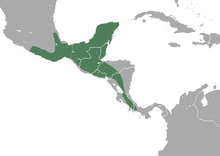Bassariscus sumichrasti
| Cacomistle | |
|---|---|
 |
|
| Scientific classification | |
| Kingdom: | Animalia |
| Phylum: | Chordata |
| Class: | Mammalia |
| Order: | Carnivora |
| Family: | Procyonidae |
| Genus: | Bassariscus |
| Species: | B. sumichrasti |
| Binomial name | |
|
Bassariscus sumichrasti (Saussure, 1860) |
|
 |
|
| Cacomistle range | |
The cacomistle, Bassariscus sumichrasti, is a nocturnal, arboreal and omnivorous member of the carnivoran family Procyonidae. Its preferred habitats are wet, tropical, evergreen woodlands and mountain forests, though seasonally it will venture into drier deciduous forests.
Nowhere in its range (from southern Mexico to western Panama) is B. sumichrasti common. This is especially true in Costa Rica, where it inhabits only a very small area. It is completely dependent on forest habitat, making it particularly susceptible to deforestation.
The term cacomistle is from the Nahuatl language (tlahcomiztli) and means "half cat" or "half mountain lion"; it is sometimes also used to refer to the ringtail, Bassariscus astutus, a similar species that inhabits arid northern Mexico and the American Southwest.
The cacomistle is part of the family Procyonidae which includes other small omnivores such as the raccoon and the coati. The cacomistle and its close relative, the ringtail, are the only living species of the subfamily Procyoninae and the genus Bassariscus. Within the Cacomistle species there are 5 subspecies (Bassariscus sumichrasti variabilis, Bassariscus sumichrasti sumichrasti, Bassariscus sumichrasti oaxacensis, Bassariscus sumichrasti notinus, and Bassariscus sumichrasti latrans).
The Central American cacomistle's body is 38–47 cm in length, which is attached to a tail of approximately the same length, if not longer (typically 39–53 cm long). The male cacomistle is often slightly longer than its female counterpart, however both male and female have approximately the same weight, usually between 1 and 1.5 kg. Their body consists of dark brown and grey fur, which stands as a stark contrast to the black and white striped tail. The tail stripes are the most defined near the animal's posterior end and gradually fade to a solid black at the end of the tail. The cacomistle is often confused with its close relative the Ring-tailed cat (Scientific name: Bassariscus astutus) because of the similarity of their appearance, but unlike the ring-tail cat the cacomistle does not have retractable claws. The cacomistle can also be identified by its faded tail and the observation of ears that come to a point.
...
Wikipedia

